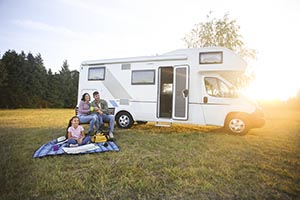A permanent change of station (PCS) is an exciting time in a military member’s life, but it also comes with its own set of hurdles that may require financial planning.
You’ve received orders for your first permanent change of station, and it’s understandable if you’re feeling some stress about the move. Moving by itself is a strenuous and taxing event, and military PCS moves come with their own set of unique hurdles to overcome. We’ve put together this list to help you plan your PCS move so you can make the most out of this next chapter in your military career.
Start building a military PCS plan
For your own ease and sanity, it’s a good idea to start this process with a plan in place; it’s also smart to act quickly, as waiting until the last minute to book moving assistance could cause complications if there aren’t enough resources left. If your orders are for a summer move, keep in mind that season is the most popular for military PCS moves, so resources rental trucks or professional movers will be limited if you wait too long.
To create your moving plan, you’re going to need to do some research first. Consider all steps of the trip, from packing and transportation to settling into your new home. How long will each step take? How far away is your new base? Where will you be living once you arrive? If you have a family, consider what neighborhood they’ll be comfortable in, as they’ll likely be spending more time at home than you will.
Start your research by contacting your base’s transportation office so they can fill you in on your options. There are also many online resources available, like the U.S. Department of Defense Military Installations site which allows you to browse by location for information about your new duty base, including information on transportation, housing, healthcare and education. To learn about housing options, contact the housing office at your new base. Military housing may be available for your family, but these housing slots fill quickly, so act fast. If your family is intending to buy or rent your home, consider using the online resources that are available such as MilitaryByOwner to help you locate homes near your base. If you plan to buy, talk to a mortgage loan officer to discuss your financing options. There are many different mortgage loans that could be a fit for you, including a VA home loan which is specifically for military members and veterans. Whatever housing you choose, be sure to check it against your budget before making any firm commitments.
Choose a PCS moving method: Military vs. PPM
When you are assigned a new base, you have the option of moving yourself or using military resources. Once you’re registered, you’ll be assigned a Transportation Service Provider (TSP). They will work with local moving companies to pack your belongings and relocate them to a warehouse while you are in transit. Then, when your new home is ready to move into, your TSP will work with local movers to unload and unpack your belongings. Storage of your household goods (HHG) does come with limitations, like not exceeding 18,000 lbs. in weight.
Your next option is to move yourself, which is called a Personally Procured Move (PPM), formerly DITY or “do-it-yourself move.” A PPM is going to take more time and effort, but you will also be reimbursed for 95% of what the government would have spent to move you. Hybrid moving options are also available in certain conditions.
The method of moving you choose should be dependent on your resources, including time, money and mental energy. Using military-provided services is convenient and the least amount of financial work. While the military will pay you upfront to move yourself if you opt for a PPM, if you overestimate the cost, you’ll have to return the difference, which can create a lot of extra work on your end.
Start saving for your military PCS
As soon as you can, start putting extra money aside for your military PCS move. While you will receive a PCS per diem during travel which will help you cover food and other expenses, it’s wise to prepare yourself for the unexpected. PCS per diem rates differ depending on location, and if you’re traveling with a family, you’ll likely want to have more cash on hand in case of emergency. You’ll also want to consider what life will be like in your new home. Are prices comparable there to where you currently reside, or will you have to adjust your budget? Will your spouse be unemployed when they were previously working? Putting aside extra funds will cushion the transition and make it less stressful for everyone involved.
Prepare for moving day
Once you know where you’re going and how you’ll get there, it’s time to start the prep work. Use this time to review your belongings and consider what you could let go of, then purge anything that’s unwanted. You could donate these items or have a yard sale, making a little extra money at the same time.
Once your personal belongings are thinned out, it’s time to catalog them for your records. Valuables like TVs and computers should be photographed, and their approximate value recorded in case they’re damaged during the move, and you need to file a claim. Just as with any move, be sure to set up local services to turn off after you relocate—think utilities and cable.
While packing, moving and traveling, always keep your most important documents with you. This includes papers like birth certificates and copies of your orders. Essentially, anything that’s irreplaceable should be transported by you and not the moving team. It’s a good idea to keep multiple copies of your military PCS orders as you will likely need quite a few during the transition.
We’re committed to helping military members and their families reach their financial goals. Learn more about military benefits available through U.S. Bank.





























































































